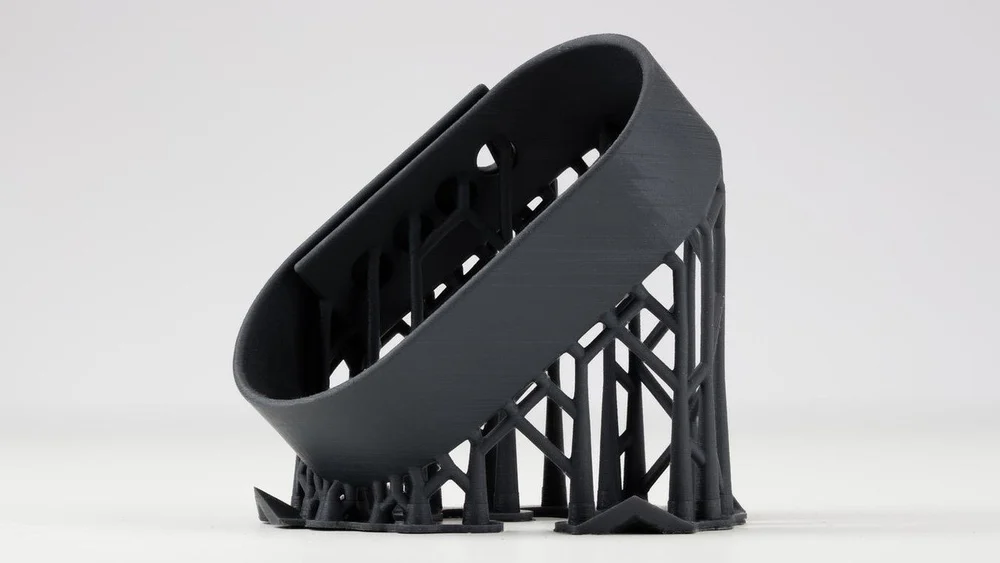Flexible resin has a number of interesting uses and properties. Check out the best brands of flexible resin for 3D printing!
What Is It?

Flexible resin is a type of UV-cured 3D printing resin that mimics the properties of rubber. It stands out for creating firm but flexible parts, and how stiff or flexible these parts are depends on the Shore hardness of the resin when cured. Most 3D printing flexible resins have a Shore hardness of around 80A, meaning they are similar to a rubber shoe heel.
Flexible resins tend to be transparent in appearance, making them a blank canvas to which you can add dye or pigment to create a color of your choice. Alternatively, you can add some flexible resin in with your usual resins to improve the tensile strength.
Always be aware that some flexible resin brands have different variants depending on your type of printer. Whether your printer is using SLA, DLP, or LCD technology, be sure to check that your resin of choice is compatible with your machine.
Printing Tips

Printing flexible resin does pose some challenges that you don’t encounter using other resins. Implementing a few tricks in the design and printing process will help to get the best quality part.
When printing flexible parts, it’s important that they are in their final form. For example, if you were printing a watchband, the model should be designed in the shape of a watchband around someone’s wrist, not flat. The reason for this is that, similar to harder types of rubber, the resin will always try to revert back to its original shape; it won’t form as well if you try to bend it into the desired shape after curing.
Print settings largely depend on the brand you’re using, but compared to other resins, you’ll probably want to increase the layer deposit and cure time for flexible resin. And to remove flexible parts from the build platform, insert a scraper under one edge and slowly peel the print off from the build platform’s surface.
Formlabs

Formlabs Flexible 80A simulates TPU or TPE with a Shore hardness of 30D. It’s best suited to functional objects like seals and gaskets or personal products like a watchband. If you need something even more flexible, their Elastic 50A resin produces results comparable with silicon.
As you would expect, these resins are intended to be used with Formlabs machines. This accounts for the higher-than-average price, as they’re high-quality resins.
- Wavelength: Not specified
- Price: ~$200 for 1 L
- Color: Transparent
- Shore hardness: 80A (Elastic resin is 50A)
Liqcreate

If you’re looking for an even bendier resin, particularly for a functional part, Liqcreate’s Flexible X is a great choice. With a Shore hardness of 55A, it has a similar feel to tire tread.
This may not sound all that soft, but the Shore hardness does vary a bit with material thickness. The thinner you make the part, the more flexible it tends to be.
Flexible X is fine to use on most DLP, LCD, and SLA 3D printers, so it’s a versatile option if you need a truly flexible part.
- Wavelength: 385-420 nm
- Price: ~$60 for 0.25 kg, ~$160 for 1 kg
- Color: Black
- Shore hardness: 55A
Monocure

Monocure Flex100 is a great choice for those who need high-quality and high-performance resin. Monocure recommends using their flexible resin in combination with their Rapid resins. If you’re after a firm durable print, use a 25:75 ratio (25 g Flex100 to 75 g Rapid resin). For a very flexible result, increase the ratio to 90:10 (90 g Flex100 to 10 g Rapid resin).
This resin can take longer than others to fully cure, with cracks possibly occurring if the resin isn’t properly cured. As a plus, if you want to do a lot of printing and 1 L containers aren’t enough, you can buy a huge 5 L container of Monocure Flex100.
- Wavelength: Not specified
- Price: ~$50 for 0.5 L, ~$95 for 1 L, $350 for 5 L
- Color: Clear
- Shore hardness: Not specified
Photocentric

Unlike other brands, Photocentric offers flexible resins for different resin technologies, namely laser, DLP, and LCD printers. Using a resin specifically designed for your type of printer is great for ensuring high-quality prints – just make sure you’re using the right one!
As a tip, clean up any Photocentric resin prints with warm water and mild detergent (rather than alcohol), otherwise, the resin will turn into a gooey mess.
- Wavelength: Not specified
- Price: ~$80 for 1 L
- Colors: Clear, black
- Shore hardness: 85A
Prusa

Prusa’s flexible resin is made in-house, like their Prusament filaments, and they strive for the same great quality. Similar to their filaments, their slicer PrusaSlicer also has built-in resin printing profiles for their resin printer, the Prusa SL1, so you can complete the whole printing process using only Prusa products!
Unusually, Prusa’s flexible filament comes in blue, in addition to the usual transparent colorway. They also make tough resin perfect for making RC model parts, along with casting resin for dental and jewelry making.
- Wavelength: 405 nm
- Price: ~$110 for 1 kg
- Colors: Transparent, blue
- Shore hardness: ~70A
Siraya Tech

Siraya Tech’s Tenacious resin is designed for LCD resin printers, and can also work with DLP printers. Best results are found when using a high-quality FEP-film-based vat and with the resin at 25 °C.
Siraya Tech also makes a plethora of resins for all your printing needs, including resins designed to be easy to print and clean, faster to print, and suitable for higher resolutions. Their flexible resin can be mixed with any resin of the same wavelength, so you can find the perfect combination of properties for your projects.
- Wavelength: 405 nm
- Price: ~$65 for 1 kg, ~$325 for 5 kg
- Color: Clear yellow
- Shore hardness: 65D